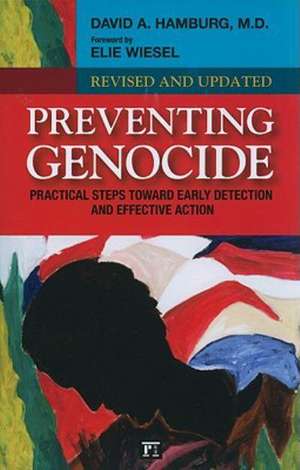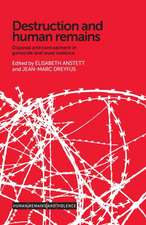Preventing Genocide: Practical Steps Toward Early Detection and Effective Action
Autor David A. Hamburgen Limba Engleză Paperback – 30 ian 2010
| Toate formatele și edițiile | Preț | Express |
|---|---|---|
| Paperback (1) | 261.82 lei 43-57 zile | |
| Taylor & Francis – 30 ian 2010 | 261.82 lei 43-57 zile | |
| Hardback (1) | 600.46 lei 43-57 zile | |
| Taylor & Francis – 30 apr 2008 | 600.46 lei 43-57 zile |
Preț: 261.82 lei
Preț vechi: 319.90 lei
-18% Nou
Puncte Express: 393
Preț estimativ în valută:
50.12€ • 54.45$ • 42.12£
50.12€ • 54.45$ • 42.12£
Carte tipărită la comandă
Livrare economică 21 aprilie-05 mai
Preluare comenzi: 021 569.72.76
Specificații
ISBN-13: 9781594515583
ISBN-10: 1594515581
Pagini: 392
Dimensiuni: 156 x 234 x 20 mm
Greutate: 0.54 kg
Ediția:Revised, Update
Editura: Taylor & Francis
Colecția Routledge
Locul publicării:Oxford, United Kingdom
ISBN-10: 1594515581
Pagini: 392
Dimensiuni: 156 x 234 x 20 mm
Greutate: 0.54 kg
Ediția:Revised, Update
Editura: Taylor & Francis
Colecția Routledge
Locul publicării:Oxford, United Kingdom
Recenzii
Read the following editorial written by Dr. Hamburg that appeared in Science magazine:
"After millennia of mass exterminations, genocides such as those in Rwanda, Bosnia, and Darfur continue to plague the world. Given today's ready access to lethal weapons and technology-assisted incitements to hatred, the plague is poised to spread. How can we reverse this potential for malignant growth?
For decades, biological and behavioral sciences have explored factors in human conflict. But explicit focus on the prevention of mass violence, especially genocide, has lagged behind until recently. A finding of practical significance is that genocide-prone behavior can be foreseen years in advance, and this period of time could be used for prevention by applying pertinent knowledge and skills, mostly of recent origin.
Studies by international collaborators, mainly social scientists and policy analysts in universities, the United Nations, and several commissions, clarify what various organizations and institutions can do to build 'pillars of prevention' that can greatly reduce the risk of genocide and other mass violence. These pillars include preventive diplomacy (such as efforts by former United Nations Secretary-General Kofi Annan to resolve conflict in Kenya) and long-term measures, especially democratic governance, equitable socioeconomic development, and constraints on weaponry.*
The pillar of education is vital in this context. Educating societies about hatred and violence is an old story in human history. But there is a better way. For example, decades of research on intergroup contact show how age-appropriate education can help people to live together harmoniously, even across previously adversarial barriers. Such intergroup contact is most effective when imbedded in shared, mutually rewarding activities that are supported by relevant authorities with a mutual aid ethic and seen as a source of benefits for all--so-called superordinate goals. Such goals may enhance intergroup relations within a school or community but also help substantially in preventing mass violence. There is no more vivid example than the recognition by the United States and the Soviet Union that avoiding nuclear war was a superordinate goal that could only be achieved by cooperation. Could global problems of food, water, health, and climate be made superordinate goals for unfriendly groups or states to tackle cooperatively?
Just as lifelong learning in mathematics, science, and technology is essential for the success of a modern economy, so too the teaching of pro-social behavior across the life-span can help to prevent immense destruction. This involves explicit information and hands-on experience with conflict resolution, violence prevention, mutual accommodation between groups, and conditions conducive to peaceful living. Evaluations of programs that emphasize pro-social behavior have identified methods that effectively teach children in these areas. Both science education and peace education require periodic updating and reinforcement on a long-term basis, and curriculum reforms cannot afford to neglect the latter as a vital component of modern education.
Schools, universities, academies, and international organizations can work together to develop and disseminate curricular material to overcome ethnocentrism, prejudice, and predisposition to violent pseudo-solutions. Good examples of such collaboration are the InterAcademy Panel and InterAcademy Council. These multinational organizations of science academies were created to mobilize the scientific community on a worldwide basis to address global needs and opportunities by advising national governments and international bodies, including the United Nations and the World Bank. It is vital to understand throughout the world the nature of human diversity and the fact of our common humanity.
"After millennia of mass exterminations, genocides such as those in Rwanda, Bosnia, and Darfur continue to plague the world. Given today's ready access to lethal weapons and technology-assisted incitements to hatred, the plague is poised to spread. How can we reverse this potential for malignant growth?
For decades, biological and behavioral sciences have explored factors in human conflict. But explicit focus on the prevention of mass violence, especially genocide, has lagged behind until recently. A finding of practical significance is that genocide-prone behavior can be foreseen years in advance, and this period of time could be used for prevention by applying pertinent knowledge and skills, mostly of recent origin.
Studies by international collaborators, mainly social scientists and policy analysts in universities, the United Nations, and several commissions, clarify what various organizations and institutions can do to build 'pillars of prevention' that can greatly reduce the risk of genocide and other mass violence. These pillars include preventive diplomacy (such as efforts by former United Nations Secretary-General Kofi Annan to resolve conflict in Kenya) and long-term measures, especially democratic governance, equitable socioeconomic development, and constraints on weaponry.*
The pillar of education is vital in this context. Educating societies about hatred and violence is an old story in human history. But there is a better way. For example, decades of research on intergroup contact show how age-appropriate education can help people to live together harmoniously, even across previously adversarial barriers. Such intergroup contact is most effective when imbedded in shared, mutually rewarding activities that are supported by relevant authorities with a mutual aid ethic and seen as a source of benefits for all--so-called superordinate goals. Such goals may enhance intergroup relations within a school or community but also help substantially in preventing mass violence. There is no more vivid example than the recognition by the United States and the Soviet Union that avoiding nuclear war was a superordinate goal that could only be achieved by cooperation. Could global problems of food, water, health, and climate be made superordinate goals for unfriendly groups or states to tackle cooperatively?
Just as lifelong learning in mathematics, science, and technology is essential for the success of a modern economy, so too the teaching of pro-social behavior across the life-span can help to prevent immense destruction. This involves explicit information and hands-on experience with conflict resolution, violence prevention, mutual accommodation between groups, and conditions conducive to peaceful living. Evaluations of programs that emphasize pro-social behavior have identified methods that effectively teach children in these areas. Both science education and peace education require periodic updating and reinforcement on a long-term basis, and curriculum reforms cannot afford to neglect the latter as a vital component of modern education.
Schools, universities, academies, and international organizations can work together to develop and disseminate curricular material to overcome ethnocentrism, prejudice, and predisposition to violent pseudo-solutions. Good examples of such collaboration are the InterAcademy Panel and InterAcademy Council. These multinational organizations of science academies were created to mobilize the scientific community on a worldwide basis to address global needs and opportunities by advising national governments and international bodies, including the United Nations and the World Bank. It is vital to understand throughout the world the nature of human diversity and the fact of our common humanity.
Cuprins
Part I Nature and Severity of the Problem; Chapter 1 Prevention of Genocide; Chapter 2 Paths to Genocide; Chapter 3 An Illustrative Genocide; Chapter 4 An Illustrative Supergenocide; Chapter 5 An Illustrative Genocide; Chapter 6 Preventing Genocide; Part II Pillars of Prevention: Strategies, Tools, and Practices; Chapter 7 Proactive Help in Preventing Mass Violence; Chapter 8 Democracy and Prevention of Mass Violence; Chapter 9 Fostering Equitable Socioeconomic Development; Chapter 10 Education for Human Survival; Chapter 11 Preventing Human Rights Abuses Through International Justice; Chapter 12 Restraints on Weaponry; Part III Institutions and Organizations: Who can do What?; Chapter 13 Potential of the United Nations for Preventing Mass Violence; Chapter 14 The Promise of the for Prevention European Union of Genocide; Chapter 15 Organisation for Security and Cooperation in Europe; Chapter 16 The North Atlantic Treaty Organization; Part IV Conclusion; Chapter 17 Summing Up; Chapter 18 International Centers for the Prevention of Genocide; Chapter 19 Recent Advances in Prevention of Mass Violence; Chapter 20 “Pioneers in the Prevention of Mass Violence”;
Descriere
Maps out numerous practical steps to recognise genocidal conflicts early and stem their tides of violence before they become large scale tragedies.




























